The UFO Events at Minot AFB (one of the best cases ever)
A Narrative of UFO Events at Minot AFB
PART 2
Thomas TulienBACKGROUND
United States Air Force, Strategic Air Command (SAC)
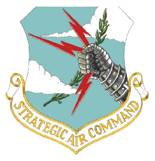
The Strategic Air Command was established on 21 March 1946, with a mandate to build an organization capable of conducting long-range air operations in any part of the world. In its dual role as a specified command of the Joint Chiefs of Staff, and a major command (MAJCOM) subordinate to Headquarters USAF, Strategic Air Command grew to become the operational establishment of the USAF in charge of America’s bomber-based and ballistic missile-based strategic nuclear arsenal until the end of the Cold War in 1992.[1]
In the early 1950s, many senior officials within the Air Force were necessarily concerned about spending limited resources in the development of long-range missiles, which ultimately may not prove to be technically feasible. By late 1951, however, these concerns were overshadowed by covert reports from the Soviet Union revealing the planned development of huge rockets, lending renewed urgency to the task of making the SAC’s retaliatory capabilities so overpowering that it could counter any Soviet aggression.

SSgt.
Billy Davis stands guard at the entrance to the Headquarters facilities of the
Strategic Air Command, Offutt AFB, Nebraska in June 1959 (Photo: National
Security Archive).
On 30 October 1953, President Dwight D. Eisenhower formally approved National Security Council Paper No. 162/2 (NSC 162/2). The top-secret document made clear that America’s nuclear arsenal would be maintained and further expanded to meet the communist threat. As a result, the SAC mission grew rapidly while defining the concept of deterrence as “instant massive retaliation.”[2] SAC implemented the long-range B-52 Stratofortress strategic nuclear bomber force in the 1950s; extending that capability in the development of the ICBM, culminating in the 1960s with the Minuteman missile program; and the eventual third leg of the strategic nuclear triad, U.S. Navy submarines with launch capabilities for ballistic missiles (SLBMs). Under this strategy, the country’s nuclear defense was assured by the use of three distinct and versatile weapons delivery systems.[3]

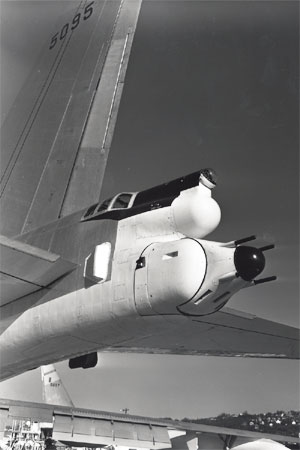
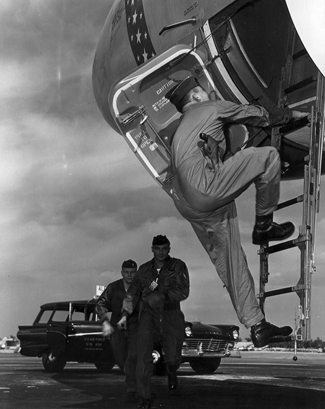
First flight of the B-52A Stratofortress on 5 August
1954. The B-52 was equipped with four separate and steerable
landing-gear units, which allowed pilots to align the landing gear with
the center of the runway while crabbing the aircraft into the wind
during crosswind landings. The first production model was the B-52B, and
over the years, the aircraft was redesigned for increased range, power,
and capability with each variant. The B-52H made its first flight on 6
March 1961 and is still in service. In all, Boeing produced 744 B-52s
between 1952 and 1962. Inset: The manned tail gun position of a
Wichita-built B-52E with its four, radar-directed .50-caliber machine
guns. In these early variants, the gunner was located in a pressurized
cabin in the tail (Photo:
Boeing).
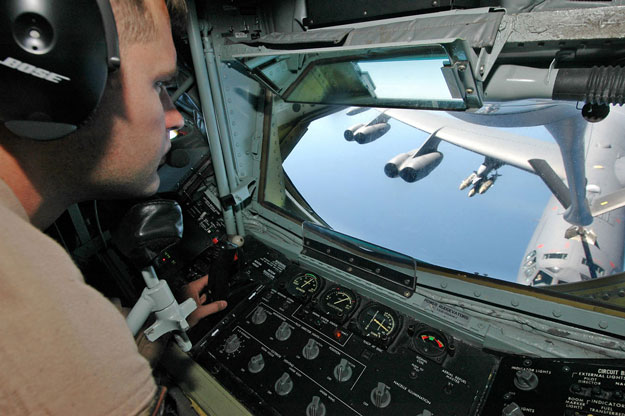
A Boeing KC-135 Stratotanker air-refueling a B-52. To
complete an aerial refueling, the tanker and receiver aircraft
rendezvous, and the receiver aircraft moves to a position behind the
tanker, aided by director lights or directions radioed by the boom
operator. Once in position, the operator extends the flying boom,
inserting it into a receptacle on the receiving aircraft. Fuel is pumped
through the boom at a rate of 1000 U.S. gallons/6500 lbs. per minute.

Photo taken at the front gate to the November-7
Launch Facility at Minot AFB (looking southeast). When the maintenance team of
A1C Isley, and A1C O’Connor arrived here at around 3:00 a.m., they were
observing the large, bright UFO circling to the south. O’Connor opened the gate
and went to the Launch Support Building adjacent to the silo, and reported to
November FSC SSgt. Bond at the N-1 LCF. Bond dispatched his Security Alert Team
to N-7.
The first generation Atlas and Titan ICBMs were activated in 1958, though by 1962 these were already being replaced with the smaller, more sophisticated second-generation Boeing Minuteman. The Minuteman was a three-stage solid-fuel propelled missile, which could be launched directly from an underground silo. Each missile stood nearly 60 feet tall, and could attain a speed of more than 15,000 miles per hour with a range of 6,300 miles. At its peak the Minuteman force numbered 1,000 missiles housed in widely dispersed underground Launch Facilities in the countryside of the Dakotas, Montana, Wyoming, Colorado, Nebraska, and Missouri, establishing the backbone of strategic deterrence.[4]

Locations of the six Minuteman ICBM complexes.
The red sites, including Malmstrom AFB, Minot AFB, and F.E. Warren AFB remain
active with 450 Minuteman III; while the black sites including Whiteman AFB,
Ellsworth AFB, and Grand Forks AFB were decommissioned in the 1990s as a result
of the Strategic Arms Reduction Treaty in 1991.
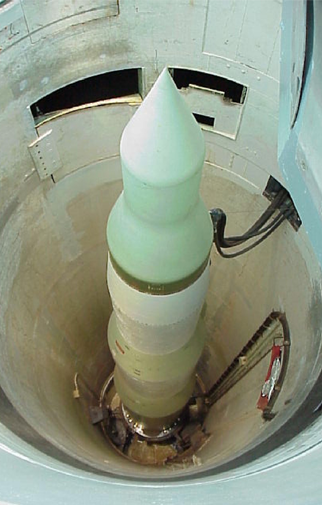

Minuteman ICBM
in its underground silo, and a test launch of the Minuteman from the Western Launch and Test Range at
Vandenberg AFB, CA. Missiles launched from silos were preceded by the
characteristic "smoke ring" that became a Minuteman trademark.

Flight sequence of a Minuteman II. Unlike the large Atlas and Titan liquid-fuel ICBMs
that rose slowly into the air, the Minuteman streaked out of the silo. Three seconds
after launch the missile began a gentle turn toward the target. The first stage
separated after 60 seconds at an altitude of nearly 19 miles. The second stage
separated at about 120 seconds, and the third stage separated from the reentry
vehicle at about 180 seconds, at which time the missile had reached an altitude
of 142 miles and was traveling at a velocity of 23,000 feet per second (15680
MPH). At the apogee of its parabolic flight path the reentry vehicle reached an
altitude of over 700 miles above the earth’s surface.
Minot Air Force Base

Following the Soviet Union’s detonation of its first atomic bomb in 1949, U.S. military strategists realized that the main attack route for enemy bombers would be over the Arctic. They therefore sought to locate radar stations and military bases in the northern tier states along the Canadian border. One of these long-range defense radar stations, Minot Air Force Station was established south of Minot, ND in 1951. A few years later, Minot was chosen as a location for a fighter-interceptor base and construction of the new facility began in May 1956. Officially activated on 10 January 1957, Minot AFB began as an Air Defense Command (ADC) base until the first permanent Strategic Air Command unit, the 4136th Strategic Wing, was activated in September 1958. Gearing up for the permanent SAC mission, in 1959 the 906th Airborne Refueling Squadron (ARFS) was assigned to Minot AFB, which grew to include a squadron of fifteen KC-135 Stratotankers providing air refueling for the defense operations and the eventual introduction of SAC aircraft.
In 1961, SAC’s mission continued to expand when the 4136th SW received a squadron of fifteen B-52H bombers, and the Air Force selected the land around Minot for a new Minuteman ICBM complex. Construction of the missile sites commenced in January 1962. In May, it was announced that the 810th Strategic Aerospace Division (SAD) would be activated at Minot AFB, and assume an intermediate level of command of both wings, subordinate to the Fifteenth Air Force.[5] On 30 June 1962, control of Minot AFB passed from ADC to the commander of the newly activated 862nd Combat Support Group, which assumed administrative responsibility for the base, while providing operations and logistical support for both wings. Thus Minot AFB was officially designated a Strategic Air Command base. With the bombing and air refueling missions well underway, all eyes turned to the missile complex.
As the complex took shape, in November 1962 SAC activated the 455th Strategic Missile Wing (SMW). Although the missile complex was far from operational, training began in order that the wing could support its mission once the construction was completed. In February 1963, SAC activated the 450th Bombardment Wing-Heavy to support the B-52 and KC-135 operations. The first Minuteman I missiles began to arrive in September 1963, and from that day on missiles arrived almost daily until the last missile was emplaced in February 1964. By April, the 455th SMW was fully operational with the Minuteman I weapon system. In just over two years, the North Dakota plains were implanted with a combat-ready ICBM system born of the latest technological advancements, and Minot AFB became the home of two powerful legs of the American strategic triad.[6]
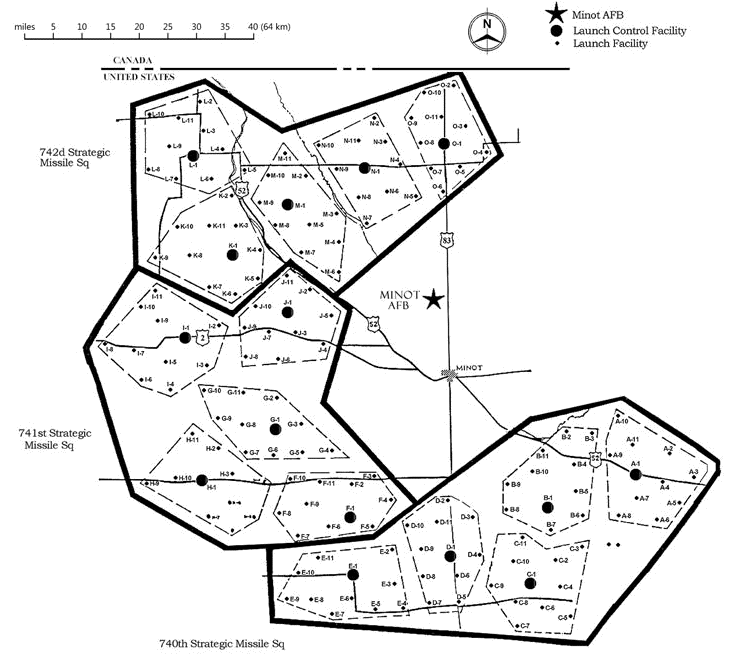
The Minuteman missile complex surrounding Minot, ND,
comprising 15 Launch Control Facilities (LCF) and 150 Launch Facilities
(LF). Each LCF and underground Launch Control Center (LCC) were
responsible for 10 Minuteman missiles housed in underground silos. The
24 October UFO events occurred to the north and northwest of Minot AFB.
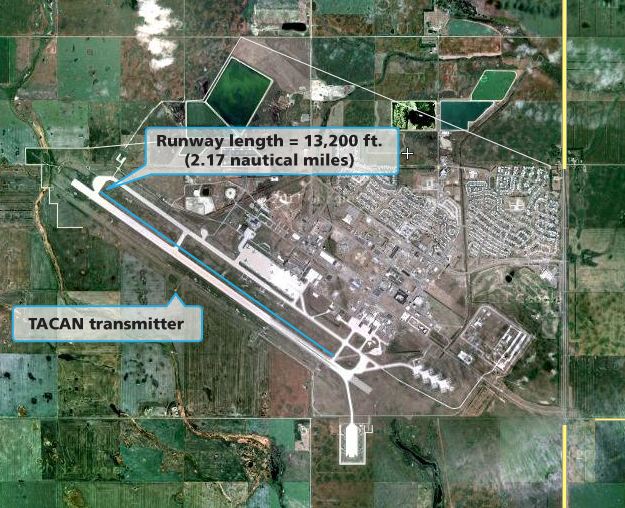
Aerial view
of Minot AFB, including the location of the Tactical Air Navigation (TACAN) UHF
transmitter beacon. TACAN is an air navigation system that provides an aircrew
with the distance (slant-range) of the aircraft, and direction of flight
(degrees-of-bearing) to the geographic location of the surface beacon.
5th Bombardment Wing-Heavy

The 5th Bombardment Wing (5th BMW) at Minot AFB consisted of the 23rd Bomb Squadron flying the B-52H Stratofortress, and the 906th Air Refueling Squadron flying the KC-135 Stratotanker. Its primary mission was to train in global strategic bombardment and defensive warfare in accordance with the Single Integrated Operational Plan (SIOP) and specified by the SAC Emergency War Order (EWO).[7] At all times there were B-52 crews poised on alert status that could be airborne within 10 minutes on their way to targets in the Soviet Union.
Rotating crews would routinely spend seven days confined in the alert facility, prepared to swiftly respond to Operation Readiness Inspections (ORI), simulating actual combat missions as though we had gone to war. They would also regularly fly airborne alert flights in which the combat-ready bombers would remain on station orbiting the North Pole, poised to go to predetermined targets in the Soviet Union. When not on alert status they routinely flew 10-hour Combat Crew training missions, involving airborne refueling, navigational legs that included simulated bombing runs, low-level flying, and overall crew proficiency exercises to maintain ratings.

Illustration of the positions of the six B-52
crewmembers, including temporary positions for the Instructor Pilot
(IP); Defense Instructor (DI); and Instructor Navigator (IN).
By the late 1960s, the Air Force was undergoing a change in regime and overall reorganization. Many of the officers and pilots who had enlisted during World War II and the Korean War were approaching retirement, and a new generation was taking their place. At the time of the 24 October 1968 UFO events, the B-52 crewmembers in this report were certified as an S-crew. As one of the top crews at Minot AFB, they did less of the day-to-day training missions, while spending more time instructing and evaluating other crews. In fact, an additional pilot, Maj. Partin, was onboard during this mission being evaluated by the Aircraft Commander Captain Don Cagle. At the time, Cagle was the youngest STANEVAL Instructor Pilot to achieve this position in SAC. In his words:
Ours was one of the first new-generation STANEVAL crews. Those guys were so good, and I was fortunate enough to put those guys together, and we kind of blazed a trail and left a pretty good wake that I’m rather proud of.[8]
91st Strategic Missile Wing
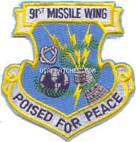
The second wing assigned to Minot AFB was the 91st Strategic Missile Wing (SMW). Its primary mission was to develop and maintain the operational capability to conduct strategic warfare according to the SAC Emergency War Order (EWO). The 91st SMW was responsible for 150 LGM-30B Minuteman I ICBMs dispersed over an area of 8,500 square miles surrounding Minot.
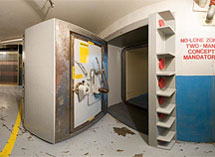
The Launch Control Center’s massive steel and
concrete blast door, which seals the capsule crew into the underground
Launch Control Center (capsule). Spherical panoramic photos of various
Launch Facilities at Ellsworth, SD, are available from: Minuteman Missile National Historic Site .
Since the missile Launch Facilities were unmanned, two Missile Combat Crew Commanders (capsule crew) stationed for 24-hour tours of duty in the underground Launch Control Center (capsule) constantly monitored missile status and security. For purposes of secure command and control communications, hardened underground cables linked the Launch Control Centers to the Launch Facilities, and ultimately to the Wing Command Post at Minot AFB.
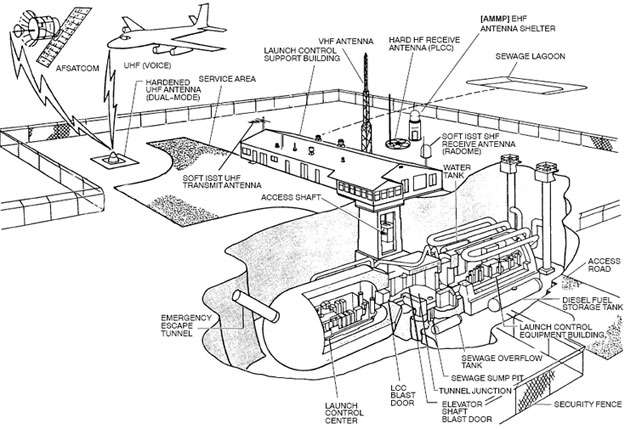
Typical aboveground Launch Control Facility (Support
Building), and underground, hardened Launch Control Center. In the late
sixties, SAC initiated the Airborne Launch Control System in which
airborne ALCS-equipped EC-135 aircraft could transmit launch codes to
the ground-based missiles in the event of a direct nuclear attack
rendering the LCC inoperable.
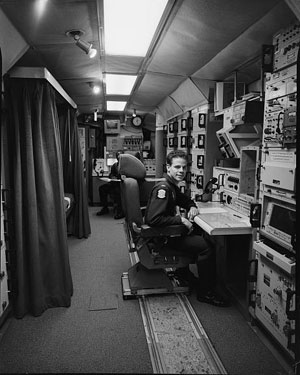
Two Missile Combat Crew Commanders stationed in front
of their communications consoles in the underground Launch Control
Center. Upon receiving a coded Emergency War Order, the crew would
verify the launch instructions and then set the required war plan and
launcher selector switches. Next, the officers would insert keys into
the launch switches, separately located at opposite ends of the LCC, and
simultaneously turn the keys to initiate the automatic launch sequence.
Sixty seconds later the missiles roared out of the underground silos,
and in thirty minutes they would reach their targets. (Photo: Library of Congress)
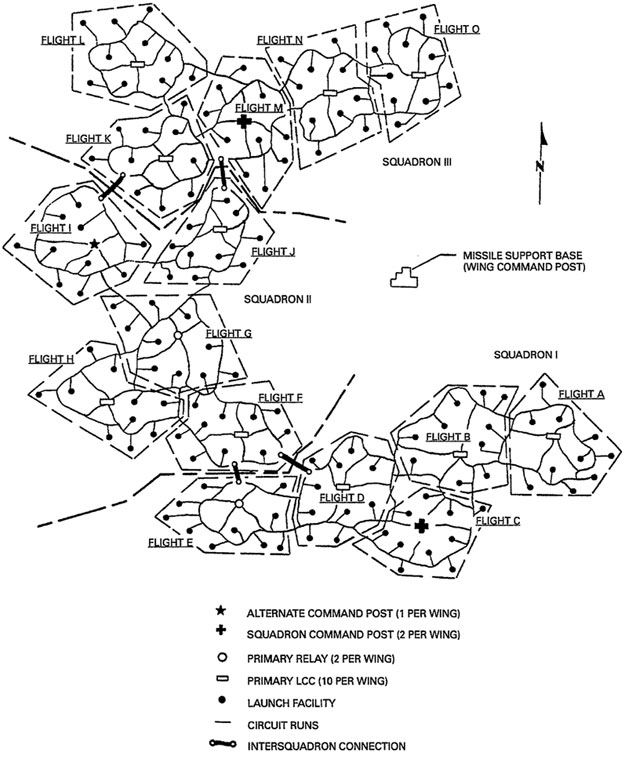
Illustration of the
Hardened Intersite Cable System at Minot AFB. The system provided secure
command and control communications for the 740th, 741st,
and 742nd Strategic Missile Squadrons, consisting of 15 underground
Launch Control Centers and 150 remote Launch Facilities. Three Squadron Command
Post (SCP) LCCs, serve as command units for their respective squadron within
the wing, and report directly to the Wing Command Post. One SCP serves as the
Alternate Command Post (ACP) for the Wing Command Post. The other 12 LCCs are
designated as primary LCCs. The four primary LCCs within each squadron report
to their respective command post (SCP).
Above ground, the Launch Control Facility (LCF) was
constantly manned by a minimum of six security personnel, who were responsible
for the security requirements of the Missile Combat Crew Commanders who remain
locked in the underground capsule for 24-hour tours of duty. The security
personnel were divided into two teams of three people each, consisting of a
Flight Security Controller (FSC) and two Security Alert Team (SAT) members.
Each team operated in 12-hour shifts over a three-day period. There was also a
facilities manager and cook at each facility totaling eight personnel at all
times.
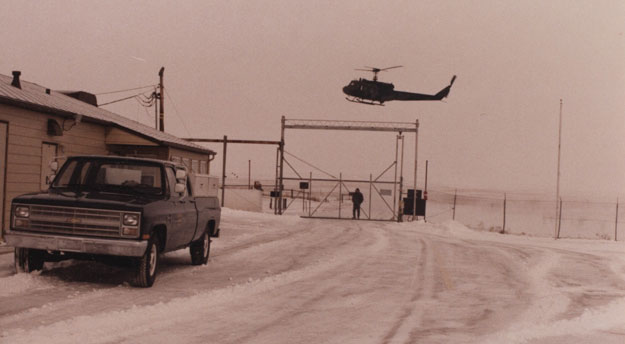
Personnel arrive by Huey helicopter during a change
of shift at a Launch Control Facility, and (above) a Flight Security
Controller on duty in the security office near the front gate (Photos: Library of Congress).
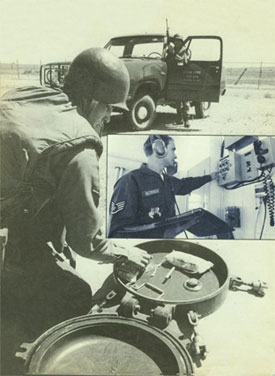

Security Alert Team at a missile Launch Facility
inspects the access hatch to a vault containing controls for opening the
Personnel Access Hatch, and (inset) a Flight Security Controller
monitoring missile-flight security status (Photo: USAF);
and a typical camper vehicle used by alert teams to provide security
whenever work was being performed in the missile silos, or alarm systems
malfunctioned at a LF and could not be reset (Photo: Library of Congress).
Airborne Launch Control System (ALCS)
By the late 1960s, the accuracy of ICBMs on both sides had improved tremendously, and Air Force planners worried that it might be possible for the Soviets to stop an entire squadron of missiles by destroying just the Launch Control Centers. The requirement for a back-up method of launching the underground Minuteman missiles became crucial. In response, the Post Attack Command and Control System (PACCS), and the Airborne Launch Control System were established, consisting of five alert EC-135 aircraft that could serve as a SAC Airborne Command Post should ground-based facilities and command centers become inoperable.Strategic Air Command began the mission on February 3, 1961. One of the five assumed the codename “Looking Glass” because the mission mirrored ground-based command, control, and communications. From that date, a Looking Glass aircraft was continuously airborne out of Offutt AFB, NE.
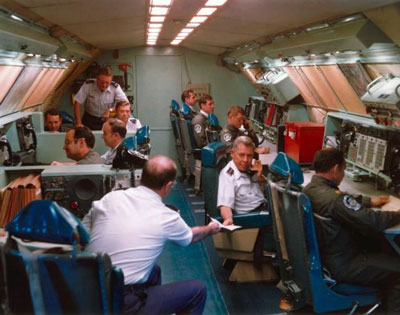
The airborne Looking
Glass battle staff, commanded by a SAC general officer, monitors several
communications systems and maintains contact with the SAC/HQ underground and
alternate command posts, the National Military Command Center, and SAC alert
forces. Looking Glass guaranteed that U.S. strategic forces would act only in
the precise manner dictated by the President (Photo: 2nd Airborne Command & Control Squadron).
End of the Cold War
Following the collapse of the Soviet Union in 1990, world conditions eased to the extent that the Strategic Air Command ended its Looking Glass operations after 29 years of continuous airborne alert. More than 281,000 hours were flown without an accident or any requirement for action. The quiet cessation of this mission seemed to speak volumes for the prospects of peace. The Cold War as we knew it in the 20th century was over.The many years researching this case have presented an opportunity to appreciate the significant accomplishments of the Strategic Air Command and the dedication of the service personnel who ultimately prevailed in the Cold War. With a nuclear striking power that exceeded the powers of every nation combined, no other military organization in all of history has possessed such awesome power, and it reflects well upon the United States that such supremacy was used to deter war.
Historian Arthur Schlesinger, Jr. noted in “Origins of the Cold War” (1967), “The orthodox American view, as originally set forth by the American government and as reaffirmed until recently by most American scholars, has been that the Cold War was the brave and essential response of free men to communist aggression.” However, he asserts that this view is simplistic and quite inadequate to an understanding of the Cold War, concluding, “Each side believed with passion that future international stability depended on its own conception of world order. Each side, in pursuing its own clearly indicated and deeply cherished principles, was only confirming the fear of the other that it was bent on aggression… Each side felt compelled to adopt policies which the other could not but regard as a threat to the principles of the peace. Each then felt compelled to undertake defensive measures… So the machinery of suspicion and countersuspicion, action and counter-action, was set in motion.”[10]
No matter what personal opinions one has on the Cold War, nuclear weapons policies, and the actions of the United States and the Soviet Union, all must recognize that the Cold War’s lasting social, economic, political, and cultural legacy is a significant part of the nation’s history, which demands to be better appreciated and understood.
Additional Resources
Minuteman Missile National Historic Site
In 1999, Congress established the Minuteman Missile National Historic Site at Ellsworth AFB, South Dakota, to "preserve, protect, and interpret for the benefit and enjoyment of present and future generations the structures associated with the Minuteman ICBM missile defense system." National Park Service staff provide tours of an intact Minuteman Launch Control Facility, and Launch FacilityA special Historical Resource Study was prepared by the National Parks Service to provide history and context for the Minuteman Missile National Historic Site in South Dakota. See: Jeffrey A. Engler (Mead & Hunt Inc.), The Missile Plains: Frontline of America’s Cold War, Prepared for United States Department of the Interior, NPS, 2003.
Panoramic photographs of Minuteman Launch Facilities.
Bruce Ecker has produced spherical panoramic images depicting some of the major features of the Delta-01 LCF, and Delta-09 LF facilities at Ellsworth AFB including several sections of the missile silo and launch support buildings not normally accessible. Available from: http://nonplused.org/panos/minuteman/index.htmlThe Nuclear Vault: Resources from the National Security Archive’s Nuclear Documentation Project
The National Security Archive is an independent non-governmental research institute and library located at The George Washington University. For students of the field, The Nuclear Vault is an excellent source of information on the history and role of nuclear weapons in U.S. policy, including reading lists, bibliographic information, links to key documents, and significant contributions in the form of Electronic Briefing Books. Available online from: The Nuclear Vault: Resources from the National Security Archive’s Nuclear Documentation Project.Three short films produced by the USAF in response to growing public concerns about safety and U.S. control of nuclear weapons are available from The Nuclear Vault at: The Air Force versus Hollywood.
- “Operation Headstart” (1959), depicts SAC’s first airborne alert test by B-52 bombers operating out of Loring AFB, ME, in the fall of 1959.
- “Development of the Soviet Ballistic Missile Threat” (1960), intelligence briefing originally classified “secret,” which illustrates the role of Air Force intelligence in the “missile gap” debates in the years before the 1960 presidential election.
- “SAC Command Post” (n.d, 1963-64), provides a detailed picture of the Strategic Air Command’s command-and-control system stationed in the lower levels of SAC headquarters at Offutt AFB, NE. The film emphasizes SAC’s place in the chain of command and the mechanisms for preventing the “unauthorized launch” of bombers and missiles that could start a nuclear war. The film was produced to refute early 1960s novels and Hollywood films such as Sidney Lumet’s Fail-Safe and Stanley Kubrick’s Dr. Strangelove, which raised questions about U.S. control over nuclear weapons.
Endnotes
[1] Specific information regarding SAC’s
mission (Basic War Plan), available resources, and organizational changes at
the time of the UFO events is available in the Archive section: Department of
the Air Force. History of the Strategic Air Command, FY 1969, Vol. I, Chapter I: “Mission, Resources,
Organization.”
[2] NSC 162/2 defined Cold War policy
during the Eisenhower administration. Central to the assessment was the
requirement for the development and maintenance of “a strong military posture,
with emphasis on the capability of inflicting massive retaliatory damage by
offensive striking power” [quote on p. 5]. Available from: http://www.fas.org/irp/offdocs/nsc-hst/nsc-162-2.pdf.
[3] For more information on the origins
and history of the Cold War, see: The Missile Plains: Frontline of America's Cold War, Section I, Chapter 1:
The Cold War (1945-62).
[4] For more information and a concise history of the U.S. ICBM programs , see: The Missile Plains: Frontline of America's Cold War, Section 1, Chapter 2: “U.S. Strategic and Missile Armament Systems (1950s-60s).”
[5] 810th SAD USAF Fact Sheet
from: http://www.afhra.af.mil/factsheets/factsheet.asp?id=10152.
The
Fifteenth Air Force, March AFB, CA was a level of command subordinate to
Strategic Air Command. The Numbered Air Forces are tactical echelons that
provide operational leadership and supervision.
[6] For more information on the history and development of the Minuteman ICBM, see: The Missile Plains: Frontline of America's Cold War, Section 1, Chapter 3: “Minuteman and the Next Generation (1960s-present).”
[7]
The Single Integrated Operational Plan (SIOP) is a blueprint which
specifies how American nuclear weapons would be used in the event of
nuclear war. The first plan was developed in 1960, consisting of a
list of targets ( National Strategic Target List) and the assets to be
used
against each target. This was extensively revised to become SIOP-62, a
massive
strike with the entire U.S. arsenal of 3,200 warheads against the USSR,
China,
and Soviet-aligned states. In 1963 the Kennedy administration revised
the plan,
resulting in SIOP-63-a strong counterforce strategy with a number of
options in
which the “no first use” policy became implicit. See also: http://www.gwu.edu/~nsarchiv/NSAEBB/NSAEBB130/index.htm.
[8] Cagle, Don 2001. Transcript of
interview by James Klotz, 18 March (Sign Oral History Project), 18.
[9] For a more complete description of
the principal assignments for each of the Air Force personnel assigned to a
Minuteman LCF and LCC, see: The Missile Plains: Frontline of America's Cold War, Section II,
Chapter
5: “Missileer Culture: Day-to-Day Life (1960s-91).” In
addition, spherical panoramic images of Minuteman launch facilities at
Ellsworth AFB, SD are available from: http://nonplused.org/panos/minuteman/index.html.
[10] Original article available from:
Schlesinger, Arthur M., Jr., “Origins of the Cold War.” Foreign Affairs, vol. 46, no. 1, October 1967, 22-52. See also: http://www.shafr.org/newsletter/2002/sep/letters.htm.
Schlesinger, Arthur M., Jr., “Origins of the Cold War.” Foreign Affairs, vol. 46, no. 1, October 1967, 22-52. See also: http://www.shafr.org/newsletter/2002/sep/letters.htm.


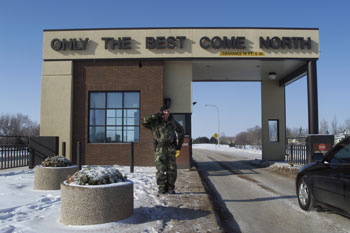
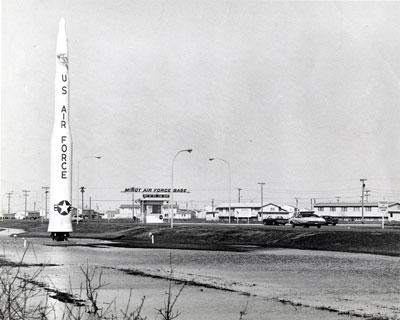



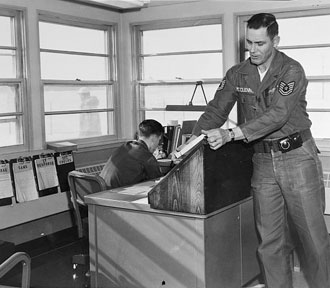
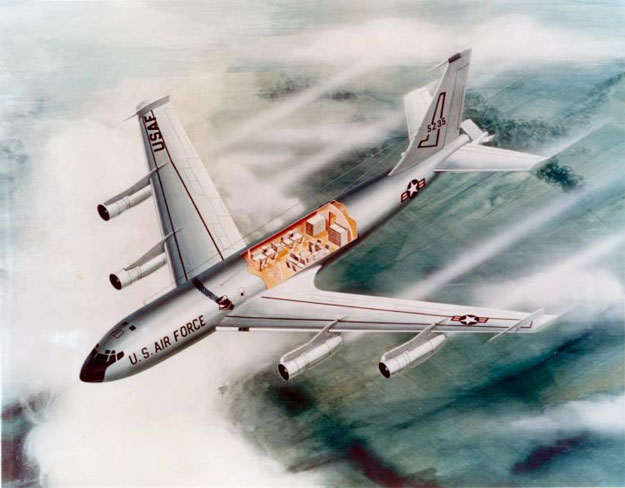
No comments:
Post a Comment